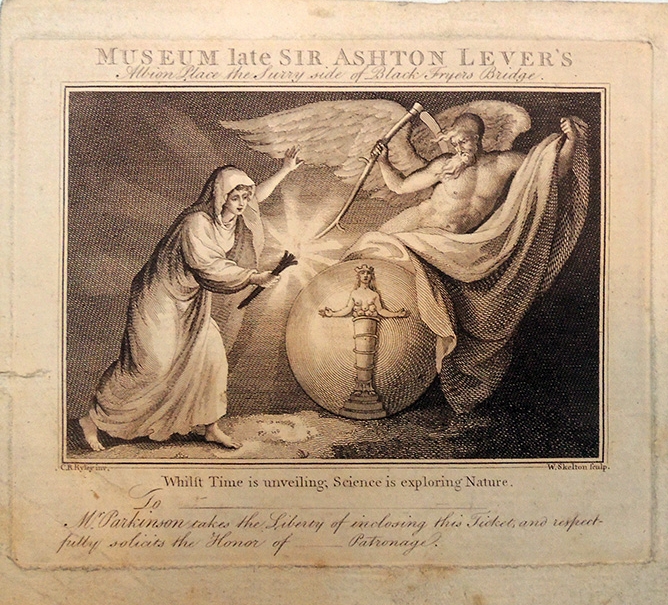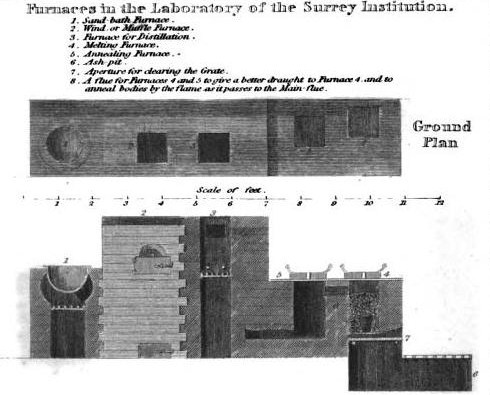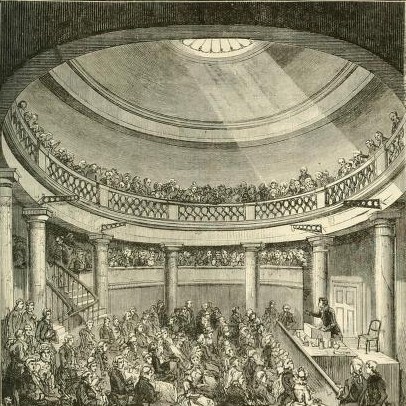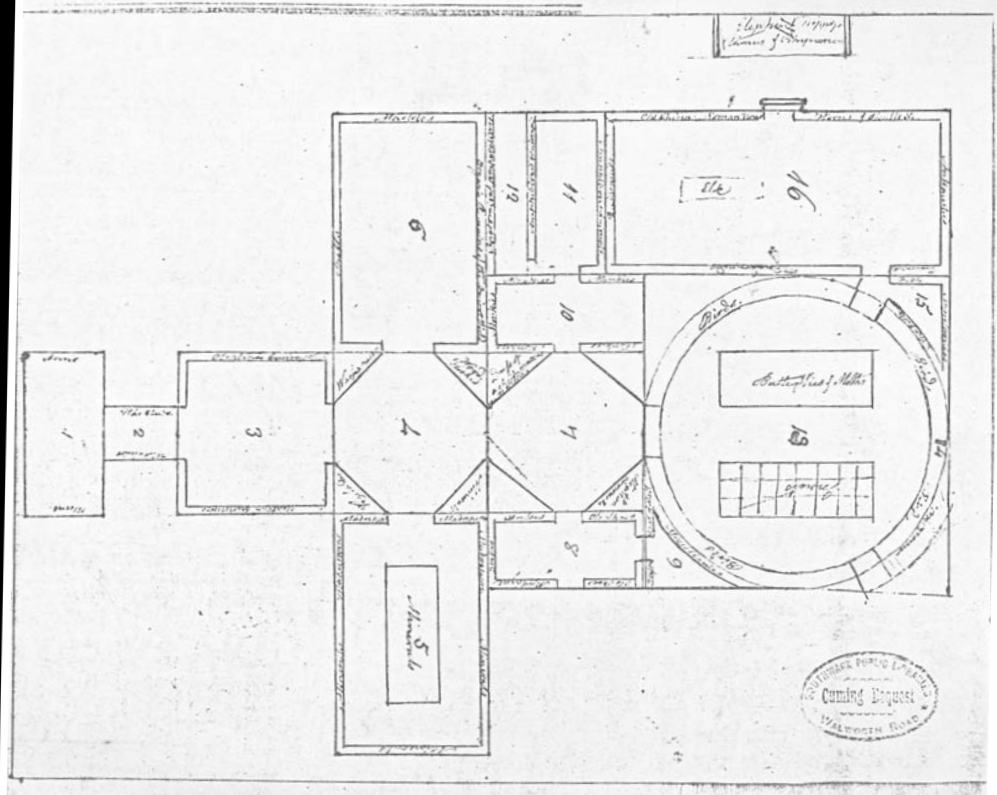Blackfriars Rotunda on:
[Wikipedia]
[Google]
[Amazon]
The Blackfriars Rotunda was a building in 

/ref>). The layout is believed to be documented only by a single surviving sketched floor plan. The Leverian collection was moved in from Leicester House in 1788. At the time the nearby buildings on Albion Place were industrial: the British Glass Warehouse by the side of the river (in business from 1773), and the Albion Mills over the street (burned down in 1791).
 A catalogue and guide was printed in 1790. He also had George Shaw write an illustrated scientific work.
A catalogue and guide was printed in 1790. He also had George Shaw write an illustrated scientific work.
 Parkinson had some success in getting naturalists to attend the museum, which was easier at the time to visit than the
Parkinson had some success in getting naturalists to attend the museum, which was easier at the time to visit than the
 The building was adapted to public lectures, in a large theatre. There were other public rooms:
The building was adapted to public lectures, in a large theatre. There were other public rooms:

by In May or June 1830
In May or June 1830
Google Books
Google Books
PDF
Numerous identifications of purchasers from the Leverian collection sale. {{coord, 51.50791, N, 0.10476, W, type:landmark_region:GB, display=title Former buildings and structures in the London Borough of Southwark Radicalism (historical)
Southwark
Southwark ( ) is a district of Central London situated on the south bank of the River Thames, forming the north-western part of the wider modern London Borough of Southwark. The district, which is the oldest part of South London, developed ...
, near the southern end of Blackfriars Bridge
Blackfriars Bridge is a road and foot traffic bridge over the River Thames in London, between Waterloo Bridge and Blackfriars Railway Bridge, carrying the A201 road. The north end is in the City of London near the Inns of Court and Temple C ...
across the River Thames
The River Thames ( ), known alternatively in parts as the The Isis, River Isis, is a river that flows through southern England including London. At , it is the longest river entirely in England and the Longest rivers of the United Kingdom, s ...
in London, that existed from 1787 to 1958 in various forms. It initially housed the collection of the Leverian Museum after it had been disposed of by lottery. For a period it was home to the Surrey Institution
The Surrey Institution was an organisation devoted to scientific, literary and musical education and research, based in London. It was founded by private subscription in 1807, taking the Royal Institution, founded in 1799, as a model.The Microcos ...
. In the early 1830s it notoriously was the centre for the activities of the Rotunda radicals
The Rotunda radicals, known at the time as Rotundists or Rotundanists, were a diverse group of social, political and religious radical reformers who gathered around the Blackfriars Rotunda, London, between 1830 and 1832, while it was under the mana ...
. Its subsequent existence was long but less remarkable.

James Parkinson and the Leverian collection

James Parkinson
James Parkinson (11 April 1755 – 21 December 1824) was an English surgeon, apothecary, geologist, palaeontologist and political activist. He is best known for his 1817 work ''An Essay on the Shaking Palsy'', in which he was the first to desc ...
came into possession of the collection of Sir Ashton Lever quite by chance: Lever put it up as a lottery prize, Parkinson's wife bought two tickets, gave one away, and died before the time the lottery draw was carried out.
Construction of the Rotunda
After trying to run the museum in its old location inLeicester Square
Leicester Square ( ) is a pedestrianised town square, square in the West End of London, England, and is the centre of London's entertainment district. It was laid out in 1670 as Leicester Fields, which was named after the recently built Leice ...
, but finding the rent too much, Parkinson with other investors put up the Rotunda Building; it was of his own design (along with his architect son Joseph Parkinson), was constructed by James Burton
James Edward Burton (born August 21, 1939, in Dubberly, Louisiana, United States) is an American guitarist. A member of the Rock and Roll Hall of Fame since 2001 (his induction speech was given by longtime fan Keith Richards), Burton has also ...
, and was opened in 1787.
The Rotunda building had a central circular gallery and in brick; the roof was conical and in slate.'The borough of Southwark: Introduction', A History of the County of Surrey: Volume 4 (1912), pp. 125-135. URL: http://www.british-history.ac.uk/report.aspx?compid=43041 Date accessed: 14 March 2012. It was located on the south side of the Thames
The River Thames ( ), known alternatively in parts as the River Isis, is a river that flows through southern England including London. At , it is the longest river entirely in England and the second-longest in the United Kingdom, after th ...
, and at the time was in the county of Surrey
Surrey () is a Ceremonial counties of England, ceremonial county in South East England. It is bordered by Greater London to the northeast, Kent to the east, East Sussex, East and West Sussex to the south, and Hampshire and Berkshire to the wes ...
. The dimensions were later given as 120 feet by 132 feet, i.e. 1760 square yards; originally the area was under 1000 square yards, however. It was located on Great Surrey Street, fronting on the Georgian terrace there (and was only later properly known as 3 Blackfriars Road, the street name being changed in 1829British History Online: Sir Howard Roberts and Walter H. Godfrey (editors), ''Survey of London: volume 22: Bankside (the parishes of St. Saviour and Christchurch Southwark)'' (1950), pp. 115-121./ref>). The layout is believed to be documented only by a single surviving sketched floor plan. The Leverian collection was moved in from Leicester House in 1788. At the time the nearby buildings on Albion Place were industrial: the British Glass Warehouse by the side of the river (in business from 1773), and the Albion Mills over the street (burned down in 1791).
Parkinson as museum owner
Parkinson made serious efforts to promote the collection as a commercial venture. A catalogue and guide was printed in 1790. He also had George Shaw write an illustrated scientific work.
A catalogue and guide was printed in 1790. He also had George Shaw write an illustrated scientific work.
 Parkinson had some success in getting naturalists to attend the museum, which was easier at the time to visit than the
Parkinson had some success in getting naturalists to attend the museum, which was easier at the time to visit than the British Museum
The British Museum is a Museum, public museum dedicated to human history, art and culture located in the Bloomsbury area of London. Its permanent collection of eight million works is the largest in the world. It documents the story of human cu ...
. A visitor in 1799, Heinrich Friedrich Link
Johann Heinrich Friedrich Link (2 February 1767 – 1 January 1851) was a German naturalist and botanist.
Biography
Link was born at Hildesheim as a son of the minister August Heinrich Link (1738–1783), who taught him love of nature through ...
, was complimentary. A description a visit to the museum for children can be found in '' The School-Room Party'' (1800).
Disposal of the collection
As well as trying to build it up as a business, Parkinson also tried to sell the contents at various times. One attempt, a proposed purchase by the government, was wrecked by the adverse opinion ofSir Joseph Banks
Sir Joseph Banks, 1st Baronet, (19 June 1820) was an English naturalist, botanist, and patron of the natural sciences.
Banks made his name on the 1766 natural-history expedition to Newfoundland and Labrador. He took part in Captain James Co ...
. In the end, for financial reasons, Parkinson sold the collection in lots by auction in 1806. Among the buyers were Edward Donovan
Edward Donovan (1768 – 1 February 1837) was an Anglo-Irish writer, natural history illustrator, and amateur zoologist. He did not travel, but collected, described and illustrated many species based on the collections of other naturalists. Hi ...
, Edward Stanley, 13th Earl of Derby
Edward Smith-Stanley, 13th Earl of Derby (21 April 1775 – 30 June 1851), styled Lord Stanley from 1776 to 1832, and Baron Stanley of Bickerstaffe from 1832–4, was an English politician, peer, landowner, builder, farmer, art collector and na ...
, and William Bullock; many items went to other museums, including the Imperial Museum of Vienna
The Natural History Museum Vienna () is a large natural history museum located in Vienna, Austria.
The NHM Vienna is one of the largest museums and non-university research institutions in Austria and an important center of excellence for all matt ...
.
Adaptation for the Surrey Institution
When the Surrey Institution was being proposed, around 1807, the Rotunda Building (as it was then known) was adapted to the Institution's needs by Joseph T. Parkinson, son of James Parkinson. The Institution ran into financial difficulties, and was closed down in 1823. The building was adapted to public lectures, in a large theatre. There were other public rooms:
The building was adapted to public lectures, in a large theatre. There were other public rooms:
Adjoining the theatre and near the inclosed part appropriated to the lecturer, is the chemical laboratory, in which convenience, compactness, and elegance are united. Contiguous to it is the committee-room. On the other side of the theatre is the library, which is sixty feet in length, with a gallery on three sides, and an easy access to it by a flight of steps.

Later uses
The building from 1823 was used in a variety of ways until 1855, when it was put to ordinary business use, as the Royal Albion pub. In the 1820s it was a wine and concert room.British History Online, ''Old and New London: Volume 6''by
Edward Walford
Edward Walford (1823–1897) was an England, English magazine editor and a compiler of educational, biographical, genealogical and touristic works, perhaps best known for the final four volumes of ''Old and New London'' (Cassell (publisher), Cas ...
(1878) pp. 368-383. It also hosted a diorama
A diorama is a replica of a scene, typically a three-dimensional model either full-sized or miniature. Sometimes dioramas are enclosed in a glass showcase at a museum. Dioramas are often built by hobbyists as part of related hobbies like mili ...
(a peristrephic panorama as described at the time), and a book about its representation of the Greek War of Independence
The Greek War of Independence, also known as the Greek Revolution or the Greek Revolution of 1821, was a successful war of independence by Greek revolutionaries against the Ottoman Empire between 1821 and 1829. In 1826, the Greeks were assisted ...
was published in 1828. Under the title Old Rotunda Assembly Rooms the Rotunda is also written into the early history of music hall
Music hall is a type of British theatrical entertainment that was most popular from the early Victorian era, beginning around 1850, through the World War I, Great War. It faded away after 1918 as the halls rebranded their entertainment as Varie ...
, for the performances of variety acts offered there in 1829, including the extemporiser Charles Sloman
Charles Sloman (1808 – 22 July 1870) was an English comic entertainer, singer and songwriter, as well as a composer of ballads and sacred music. He was billed as "the only English ''Improvisatore''".
Biography
Born in Westminster into a ...
.
 In May or June 1830
In May or June 1830 Richard Carlile
Richard Carlile (8 December 1790 – 10 February 1843) was an English radical publisher and writer. He was an important agitator for the establishment of universal suffrage and freedom of the press in the United Kingdom.
Early life and career ...
took over the Rotunda, and it became a centre for radical lectures and meetings. There were also waxworks and wild beasts. The Rotunda radicals
The Rotunda radicals, known at the time as Rotundists or Rotundanists, were a diverse group of social, political and religious radical reformers who gathered around the Blackfriars Rotunda, London, between 1830 and 1832, while it was under the mana ...
, known at the time as Rotundists or Rotundanists, were a diverse group of social, political and religious radical reformers who gathered there, between 1830 and 1832, during Carlile's tenure. During this period almost every well-known radical in London spoke there at meetings which were often rowdy. The Home Office regarded the Rotunda as a centre of violence, sedition and blasphemy, and regularly spied on its meetings. In 1831 it was described as the Surrey Rotunda on Albion Place (the area south of Blackfriars Bridge
Blackfriars Bridge is a road and foot traffic bridge over the River Thames in London, between Waterloo Bridge and Blackfriars Railway Bridge, carrying the A201 road. The north end is in the City of London near the Inns of Court and Temple C ...
, with the industrial buildings) leading to Albion Street.
From 1833 to 1838 it operated as the Globe Theatre; under John Blewitt it was called a "musick hall",Phyllis Hartnoll and Peter Found. "Rotunda, The." The Concise Oxford Companion to the Theatre. 1996. Encyclopedia.com. (March 14, 2012). http://www.encyclopedia.com/doc/1O79-RotundaThe.html and in 1838 the Rotunda was again a concert room. George Jacob Holyoake
George Jacob Holyoake (13 April 1817 – 22 January 1906) was an English secularist, co-operator and newspaper editor. He coined the terms secularism in 1851 and " jingoism" in 1878. He edited a secularist paper, ''The Reasoner'', from 1846 to ...
was teaching and lecturing there in 1843. At a later point it was the Britannia Music Hall. After an illegal cock fight
Cockfighting is a blood sport involving domesticated roosters as the combatants. The first documented use of the word gamecock, denoting use of the cock as to a "game", a sport, pastime or entertainment, was recorded in 1634, after the term ...
was discovered, the Rotunda finally lost its entertainment licence, in 1886.
In 1912 the Rotunda was in use as a warehouse. The structure was damaged during World War II
World War II or the Second World War (1 September 1939 – 2 September 1945) was a World war, global conflict between two coalitions: the Allies of World War II, Allies and the Axis powers. World War II by country, Nearly all of the wo ...
, and had been patched up by 1950. It was demolished in 1958.Parolin, p. 278Google Books
References
*Christina Parolin (2010), ''Radical Spaces: Venues of popular politics in London, 1790–c. 1845''Google Books
Notes
External links
*P. J. P. Whitehead, ''A Guide to the Dispersal of Zoological Material from Captain Cook's Voyages'', Pacific Studies, Vol 2, No 1 (1978)Numerous identifications of purchasers from the Leverian collection sale. {{coord, 51.50791, N, 0.10476, W, type:landmark_region:GB, display=title Former buildings and structures in the London Borough of Southwark Radicalism (historical)